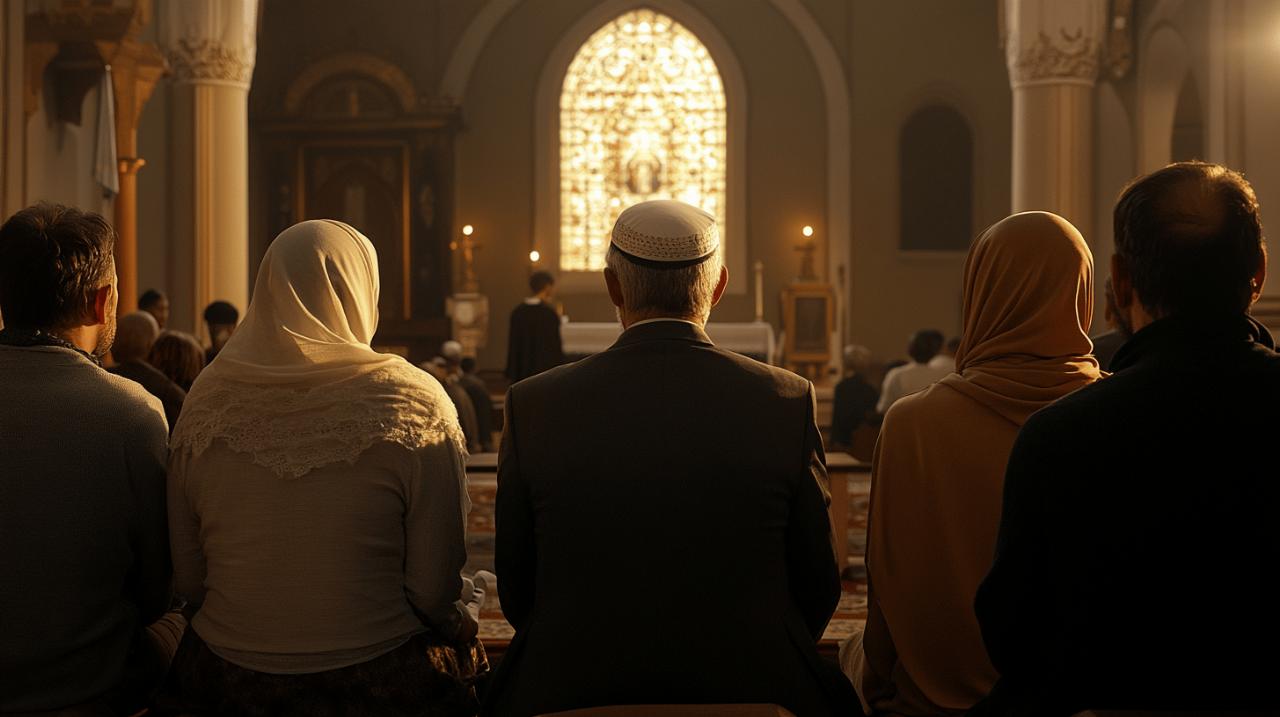The question of where Muslims may offer their prayers has sparked considerable discussion, particularly as communities become more diverse and interconnected. For many, the idea of praying within a church might seem unusual or even inappropriate, yet Islamic teachings offer a surprisingly flexible approach. Understanding the nuances of Islamic jurisprudence on prayer locations reveals a faith tradition that values both devotion and practicality, recognising that the act of worship itself transcends specific architectural boundaries. This exploration delves into the principles guiding Muslim prayer, the shared heritage of Abrahamic faiths, and the conditions under which praying in a church might be considered permissible.
Understanding islamic principles on prayer locations
The Significance of Clean and Pure Spaces in Islamic Worship
Islamic tradition places significant emphasis on the purity and cleanliness of the space where prayer is performed. The Prophet Muhammad famously stated that the entire earth has been made a place for prayer and purification, a special dispensation that distinguishes Islam from other monotheistic traditions. This foundational teaching suggests that Muslims are not bound exclusively to mosques or designated prayer halls. Instead, any clean and pure location can serve as an appropriate venue for connecting with the divine. The concept of ritual purity requirements extends beyond the individual worshipper to encompass the physical space itself, which must be free from filth and impurities. This principle underpins the flexibility inherent in Islamic worship, allowing believers to fulfil their obligations even when a traditional mosque is not accessible.
The emphasis on cleanliness and purity does not merely reflect a concern for physical hygiene but also carries spiritual significance. A clean prayer surface symbolises respect for the act of worship and the presence of Allah. When Muslims seek alternative prayer venues, they must ensure that the space meets these fundamental standards. This requirement becomes particularly relevant for those working in hospitals, universities, or other settings where dedicated Muslim prayer rooms may not always be available. In such circumstances, the focus shifts to identifying spaces that meet the necessary conditions, rather than insisting upon a specific type of building or religious designation.
Mosques versus alternative prayer venues: what islamic jurisprudence says
While mosques remain the traditional and preferred venues for communal worship, Islamic jurisprudence acknowledges that circumstances may necessitate praying elsewhere. The concept that the earth itself functions as a mosque for Muslims reflects a pragmatic approach to worship, recognising the realities of travel, work commitments, and the absence of nearby Islamic centres. Scholars across different schools of thought have addressed the validity of prayer in non-mosque settings, generally agreeing that the prayer remains valid as long as essential conditions are met. These conditions include facing the Qiblah direction, observing the correct timing for the five daily prayers, covering the body appropriately, and ensuring the area is free from impurities.
The flexibility within Islamic jurisprudence on prayer locations becomes especially important for Muslims living in regions where mosques are scarce or inaccessible. Junior doctors in the United Kingdom, for instance, often face the challenge of finding suitable spaces to observe Juma prayers during work hours. In such cases, multi-faith prayer rooms or even churches have been utilised, prompting questions about the validity of these practices. Islamic scholars have addressed these concerns by emphasising that necessity overrides preference. When no mosque is available, and the time for prayer is approaching, Muslims are permitted to use alternative spaces, provided they meet the basic requirements of cleanliness and purity. This pragmatic approach ensures that the obligation to pray is not compromised by external circumstances.
The Shared Heritage of Abrahamic Faiths and Worship Spaces
Recognising common ground between islam, christianity, and judaism
Islam acknowledges the shared Abrahamic roots with Christianity and Judaism, recognising churches and synagogues as places where the oneness of God has been worshipped throughout history. The Quran itself references these places of worship with a degree of respect, acknowledging the devotion of believers from other monotheistic traditions. This recognition forms the theological basis for the nuanced understanding of whether Muslims can pray in churches or synagogues. The common ground shared by these faiths lies in their commitment to monotheism and the worship of the same divine creator, even if the specific practices and beliefs differ in significant ways.
The acknowledgment of this shared heritage does not imply that all worship spaces are interchangeable, but it does open the door to a more flexible interpretation of where Muslims may pray when circumstances require it. The respect accorded to churches and synagogues within Islamic tradition suggests that these are not merely secular buildings but spaces imbued with spiritual significance. This perspective is particularly relevant in contexts where interfaith dialogue and cooperation are increasingly valued. By recognising the common ground between Abrahamic faiths, Muslims can approach the question of praying in churches with a sense of respect and openness, rather than rigid exclusion.
Historical Precedents of Muslims Praying in Churches and Synagogues
Historical precedents provide valuable insights into how early Muslims navigated the question of praying in non-Muslim places of worship. Some companions of the Prophet Muhammad are known to have prayed in churches when the need arose, suggesting that such practices were not considered inherently problematic. These historical examples offer a precedent for contemporary Muslims who find themselves in similar situations, whether due to travel, work commitments, or the absence of nearby mosques. The actions of these early Muslims demonstrate a pragmatic approach to worship, prioritising the obligation to pray over the specific type of building in which the prayer is performed.
One particularly notable example involves Umar Ibn Al-Khattab, the second caliph, who visited a church in Jerusalem but chose not to pray inside it. His reasoning was rooted in a concern that future generations of Muslims might mistakenly assume the church was a Muslim place of worship, potentially leading to disputes or inappropriate claims over the building. This incident illustrates the careful balance that early Islamic leaders sought to maintain between honouring the obligation to pray and respecting the religious spaces of other communities. While Umar's decision not to pray inside the church reflects a degree of caution, it does not constitute an outright prohibition. Instead, it highlights the importance of context and the need to consider the broader implications of one's actions.
Conditions and Considerations for Muslim Prayer in Churches
Addressing Concerns About Imagery and the Concept of Tawhid
 One of the primary concerns regarding praying in churches relates to the presence of religious imagery, such as statues, icons, and crucifixes, which may conflict with the Islamic emphasis on the oneness of God, known as Tawhid. Islamic teachings strongly discourage the representation of divine figures, as such images can be seen as potential distractions or even as conflicting with the principle of monotheism. This concern is rooted in the belief that angels do not enter places where images are present, a tradition that some scholars interpret as a reason to avoid praying in churches that contain such representations.
One of the primary concerns regarding praying in churches relates to the presence of religious imagery, such as statues, icons, and crucifixes, which may conflict with the Islamic emphasis on the oneness of God, known as Tawhid. Islamic teachings strongly discourage the representation of divine figures, as such images can be seen as potential distractions or even as conflicting with the principle of monotheism. This concern is rooted in the belief that angels do not enter places where images are present, a tradition that some scholars interpret as a reason to avoid praying in churches that contain such representations.
Despite these concerns, many Islamic scholars adopt a more nuanced position, acknowledging that necessity may override preference. If a Muslim has no other option but to pray in a church, and the time for prayer is approaching, the prayer remains valid even in the presence of images, provided certain precautions are taken. Covering the statues or images during prayer is one such precaution, as it minimises the potential for distraction and symbolically removes the problematic elements from the immediate prayer space. Additionally, using a Sutrah, a barrier placed in front of the worshipper, can help to focus concentration and avoid looking directly at the images. These measures reflect a practical approach to balancing the need to fulfil the prayer obligation with the desire to maintain the integrity of Islamic principles.
Finding appropriate spaces within multi-faith settings
In contemporary settings, multi-faith prayer rooms have become increasingly common in universities, hospitals, and workplaces. These spaces are designed to accommodate the needs of diverse religious communities, offering a neutral environment where individuals of different faiths can worship. For Muslims, the suitability of these rooms depends on whether they meet the basic requirements for prayer, including cleanliness, the absence of alcohol, and minimal religious imagery that might cause distraction. Ideally, Muslims should have their own dedicated prayer spaces built according to Islamic Shariah, but when such facilities are not available, multi-faith rooms serve as a practical alternative.
When using a multi-faith room or a church for prayer, Muslims are encouraged to seek permission from the relevant authorities, demonstrating respect for the space and the community that maintains it. This practice aligns with the Islamic principle of respecting other religions' places of worship, recognising that these buildings hold spiritual significance for their respective communities. By asking for permission and ensuring that their use of the space does not cause inconvenience or offence, Muslims can foster positive relationships with people of other faiths. This approach not only adheres to Islamic teachings but also contributes to a broader culture of mutual respect and understanding.
Fostering interfaith dialogue through shared worship spaces
Building Bridges of Understanding Between Muslim and Christian Communities
The question of whether Muslims can pray in churches extends beyond jurisprudential technicalities to touch on broader themes of interfaith dialogue and community relations. In an increasingly interconnected world, opportunities for people of different faiths to interact and learn from one another are more abundant than ever. Shared worship spaces, whether multi-faith prayer rooms or churches opened to Muslims in times of need, can serve as powerful symbols of religious tolerance and mutual respect. These spaces offer tangible evidence that different faith communities can coexist peacefully and support one another in their spiritual journeys.
Engaging in interfaith dialogue through shared worship spaces requires a commitment to understanding and respecting the beliefs and practices of others. For Muslims, this means recognising that Christians, equally devoted to God, often welcome respectful visitors who wish to pray. For Christians, it involves appreciating the Islamic emphasis on monotheism and the specific requirements that govern Muslim prayer. When both communities approach the question with openness and a willingness to accommodate one another, the result is often a strengthening of communal bonds and a deepening of mutual respect. Such interactions can challenge misconceptions and stereotypes, fostering a more nuanced understanding of what it means to be a person of faith in a diverse society.
The Role of Mutual Respect in Creating Welcoming Prayer Environments
Mutual respect is the cornerstone of any effort to create welcoming prayer environments that serve the needs of diverse religious communities. For Muslims considering whether to pray in a church, the decision often hinges on whether they feel that their presence will be respected and that their specific requirements can be met. This respect must be reciprocal, with Muslims demonstrating consideration for the sensitivities of the Christian community and the sanctity of the church as a place of worship. Asking for permission before using the space, ensuring that the area is left clean and undisturbed, and avoiding any actions that might be perceived as disrespectful are all essential components of this respectful approach.
The concept of mutual respect also extends to the broader question of how different faith communities interact and support one another. In many parts of the world, including the United Kingdom, examples of churches opening their doors to Muslims during times of need have become increasingly common. These gestures of hospitality not only provide practical solutions to the challenges faced by Muslims in finding suitable prayer spaces but also send a powerful message about the values of compassion and solidarity that transcend religious boundaries. By fostering environments where mutual respect is the norm, communities can create spaces that are truly welcoming to all, regardless of their faith tradition. This approach not only addresses the immediate practical concerns but also contributes to a broader culture of peace and understanding that benefits society as a whole.






